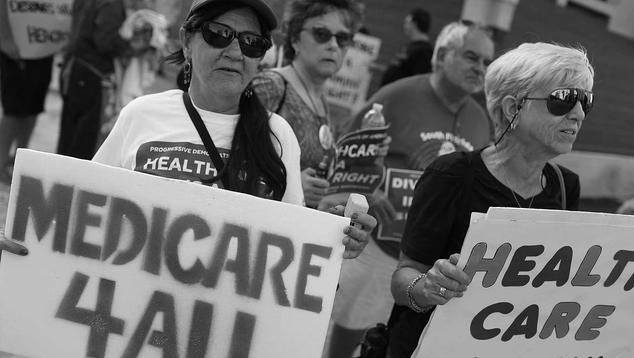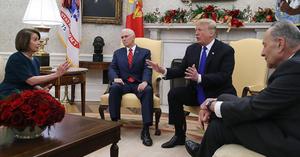Now that a federal judge has sided with 20 states to strike down the 2010 Affordable Care Act (also known as Obamacare) as unconstitutional, the political effects of the healthcare issue have returned to center stage. Even before that Dec. 14 decision, however, voters in the 2018 midterm elections were focused on healthcare, with 41% telling exit pollsters it was the most important issue to their vote -- the highest of any issue rated. The economy was key for 21% and immigration for 23%.
Republicans had reportedly hoped to defend their majority status in Congress by reminding voters of the positive economic growth and tax cuts achieved in the prior two years. Democrats' message seemed centered on protecting Obamacare, in particular the pre-existing medical conditions clause, as a counterweight to Republicans' economic messaging. The immigration issue, which the GOP tried to capitalize on late in the campaign, proved too weak of a salient to alter this dynamic.
Not only was healthcare a top influencer in the recent congressional elections, but it may have been the key activator of a significant "swing vote" that went largely undetected by party professionals.
Voters' Concerns and Trump's Base Before the Midterms
For most of the year, an abundance of political analysis was trained on the durability of the conservative Trump base and whether it could be expanded and stimulated to match the turnout energy of the liberal anti-Trump resistance. However, the degree of difficulty Republicans faced may have been underestimated given public concerns about healthcare -- not only among Democrats, but also among a sizable group of Republicans.
A Gallup survey in early November found 53% of U.S. adults at the time of the election approving of Trump's economic direction for the country, but only 36% approving of his handling of healthcare policy. Those who approved of Trump on the economy but not healthcare should have been prime targets for Republican healthcare messaging to keep them in the GOP fold. Without that, this group had strong reasons to vote against Trump's party.
Using the November study, the "Hardcore Trump Base" can be defined as the 34% of respondents who approved of both Trump's economic policies and his healthcare policies. The "Anti-Trump Resistance" were the 40% who disapproved of him on both issues, while the "Healthcare Swing Voters" were the 16% who approved of him on the usually paramount issue of the economy while disapproving of him on healthcare. The remaining 10% mostly included those with no opinion about Trump's performance on one or both issues, and therefore may have been less motivated to participate in the election.
The key point of these figures is that the Trump administration was trying to protect the Republican majority in Congress with a six-percentage-point disadvantage relative to the Democrats in these strategic-issue groups. Not coincidentally, the six-point deficit between the Hardcore Trump Base and the Anti-Trump Resistance is very close to Democrats' eight-point margin of victory in the vote for the House of Representatives, as calculated by the national two-party vote.
| Midterm Issue Groups^ | ||||||||||||||||||||||||||||||||||||||||||||||||||||||||||||||||||||||||||||||||||||||||||||||||||||
|---|---|---|---|---|---|---|---|---|---|---|---|---|---|---|---|---|---|---|---|---|---|---|---|---|---|---|---|---|---|---|---|---|---|---|---|---|---|---|---|---|---|---|---|---|---|---|---|---|---|---|---|---|---|---|---|---|---|---|---|---|---|---|---|---|---|---|---|---|---|---|---|---|---|---|---|---|---|---|---|---|---|---|---|---|---|---|---|---|---|---|---|---|---|---|---|---|---|---|---|---|
| Hardcore Trump Base (approve on economy, healthcare) | 34% | |||||||||||||||||||||||||||||||||||||||||||||||||||||||||||||||||||||||||||||||||||||||||||||||||||
| Anti-Trump Resistance (disapprove on economy, healthcare) | 40% | |||||||||||||||||||||||||||||||||||||||||||||||||||||||||||||||||||||||||||||||||||||||||||||||||||
| Difference | -6 | |||||||||||||||||||||||||||||||||||||||||||||||||||||||||||||||||||||||||||||||||||||||||||||||||||
| 2018 House Midterm Votes^^ | ||||||||||||||||||||||||||||||||||||||||||||||||||||||||||||||||||||||||||||||||||||||||||||||||||||
| Votes cast for Republican candidates | 45% | |||||||||||||||||||||||||||||||||||||||||||||||||||||||||||||||||||||||||||||||||||||||||||||||||||
| Votes cast for Democratic candidates | 53% | |||||||||||||||||||||||||||||||||||||||||||||||||||||||||||||||||||||||||||||||||||||||||||||||||||
| Difference | -8 | |||||||||||||||||||||||||||||||||||||||||||||||||||||||||||||||||||||||||||||||||||||||||||||||||||
| ^Gallup, Nov. 1-11, 2018; ^^The Cook Political Report | ||||||||||||||||||||||||||||||||||||||||||||||||||||||||||||||||||||||||||||||||||||||||||||||||||||
Swing Voters and the Importance of Healthcare Worries
According to the November Gallup poll, 89% of the Hardcore Trump Base were Republicans (or Republican-leaning independents) and 85% of the Anti-Trump Resistance were Democrats (or Democratic-leaning independents).
The most interesting group, however, may be the Healthcare Swing Voters -- those who liked Trump's economic policies but disapproved of his leadership on national healthcare. This group had the potential to play a pivotal role in expanding Trump's base and at least narrowing the six-point gap between the pro-Trump and anti-Trump groups.
The party ID breakdown of this group was 48% Republican/lean Republican and 45% Democratic/lean Democratic. In terms of political ideology, it was more moderate than conservative, by 50% to 31% -- far less conservative than the Hardcore Trump Base. But it was similar to the Trump base in terms of having slightly higher income. And, like the Trump base, it was heavily male.
| Hardcore Trump Base | Healthcare Swing Voters | Anti-Trump Resistance | ||||||||||||||||||||||||||||||||||||||||||||||||||||||||||||||||||||||||||||||||||||||||||||||||||
|---|---|---|---|---|---|---|---|---|---|---|---|---|---|---|---|---|---|---|---|---|---|---|---|---|---|---|---|---|---|---|---|---|---|---|---|---|---|---|---|---|---|---|---|---|---|---|---|---|---|---|---|---|---|---|---|---|---|---|---|---|---|---|---|---|---|---|---|---|---|---|---|---|---|---|---|---|---|---|---|---|---|---|---|---|---|---|---|---|---|---|---|---|---|---|---|---|---|---|---|---|
| % | % | % | ||||||||||||||||||||||||||||||||||||||||||||||||||||||||||||||||||||||||||||||||||||||||||||||||||
| Gender | ||||||||||||||||||||||||||||||||||||||||||||||||||||||||||||||||||||||||||||||||||||||||||||||||||||
| Men | 56 | 67 | 35 | |||||||||||||||||||||||||||||||||||||||||||||||||||||||||||||||||||||||||||||||||||||||||||||||||
| Women | 44 | 33 | 65 | |||||||||||||||||||||||||||||||||||||||||||||||||||||||||||||||||||||||||||||||||||||||||||||||||
| Age | ||||||||||||||||||||||||||||||||||||||||||||||||||||||||||||||||||||||||||||||||||||||||||||||||||||
| 18-49 | 46 | 58 | 57 | |||||||||||||||||||||||||||||||||||||||||||||||||||||||||||||||||||||||||||||||||||||||||||||||||
| 50+ | 54 | 43 | 43 | |||||||||||||||||||||||||||||||||||||||||||||||||||||||||||||||||||||||||||||||||||||||||||||||||
| Education | ||||||||||||||||||||||||||||||||||||||||||||||||||||||||||||||||||||||||||||||||||||||||||||||||||||
| Graduated from college | 28 | 34 | 38 | |||||||||||||||||||||||||||||||||||||||||||||||||||||||||||||||||||||||||||||||||||||||||||||||||
| Did not graduate from college | 72 | 64 | 62 | |||||||||||||||||||||||||||||||||||||||||||||||||||||||||||||||||||||||||||||||||||||||||||||||||
| Income | ||||||||||||||||||||||||||||||||||||||||||||||||||||||||||||||||||||||||||||||||||||||||||||||||||||
| <$75,000 | 59 | 57 | 62 | |||||||||||||||||||||||||||||||||||||||||||||||||||||||||||||||||||||||||||||||||||||||||||||||||
| $75,000+ | 41 | 43 | 38 | |||||||||||||||||||||||||||||||||||||||||||||||||||||||||||||||||||||||||||||||||||||||||||||||||
| Party ID | ||||||||||||||||||||||||||||||||||||||||||||||||||||||||||||||||||||||||||||||||||||||||||||||||||||
| Republicans | 89 | 48 | 4 | |||||||||||||||||||||||||||||||||||||||||||||||||||||||||||||||||||||||||||||||||||||||||||||||||
| Independents | 4 | 7 | 11 | |||||||||||||||||||||||||||||||||||||||||||||||||||||||||||||||||||||||||||||||||||||||||||||||||
| Democrats | 7 | 45 | 85 | |||||||||||||||||||||||||||||||||||||||||||||||||||||||||||||||||||||||||||||||||||||||||||||||||
| Ideology | ||||||||||||||||||||||||||||||||||||||||||||||||||||||||||||||||||||||||||||||||||||||||||||||||||||
| Conservatives | 61 | 31 | 11 | |||||||||||||||||||||||||||||||||||||||||||||||||||||||||||||||||||||||||||||||||||||||||||||||||
| Moderates | 30 | 50 | 38 | |||||||||||||||||||||||||||||||||||||||||||||||||||||||||||||||||||||||||||||||||||||||||||||||||
| Liberals | 5 | 15 | 47 | |||||||||||||||||||||||||||||||||||||||||||||||||||||||||||||||||||||||||||||||||||||||||||||||||
| Gallup, Nov. 1-11, 2018 | ||||||||||||||||||||||||||||||||||||||||||||||||||||||||||||||||||||||||||||||||||||||||||||||||||||
Thus, the Healthcare Swing Voters should have been more of a target for the Trump administration in the midterms, recognizing that these voters valued Trump's leadership on the economy but harbored concerns about him on healthcare. In other words, a case could be made that the Trump administration's failure to address weaknesses in the healthcare system -- whether through a restructuring of Obamacare or something else -- was enough of a toxin in the political waters to cause some of Trump's economic supporters to get peeled off by instability in the healthcare market.
So, what drove the disapproval of Trump's healthcare policies among this swing group that leaned Republican but was more moderate in ideology?
Gallup's November poll also measured public concern about four major healthcare issues, all of which were prominently discussed by both parties leading up to the midterms -- coverage for pre-existing conditions, the possibility of higher health insurance premiums, loss of healthcare coverage and healthcare affordability. The table below shows that the Healthcare Swing Voters were much more concerned than the Hardcore Trump Base about all four issues, particularly in terms of healthcare costs.
| Hardcore Trump Base | Healthcare Swing Voters | Anti-Trump Resistance | |||||||||||||||||||||||||||||||||||||||||||||||||||||||||||||||||||||||||||||||||||||||||||||||||
|---|---|---|---|---|---|---|---|---|---|---|---|---|---|---|---|---|---|---|---|---|---|---|---|---|---|---|---|---|---|---|---|---|---|---|---|---|---|---|---|---|---|---|---|---|---|---|---|---|---|---|---|---|---|---|---|---|---|---|---|---|---|---|---|---|---|---|---|---|---|---|---|---|---|---|---|---|---|---|---|---|---|---|---|---|---|---|---|---|---|---|---|---|---|---|---|---|---|---|---|
| % | % | % | |||||||||||||||||||||||||||||||||||||||||||||||||||||||||||||||||||||||||||||||||||||||||||||||||
| Losing coverage over a pre-existing condition | 23 | 43 | 59 | ||||||||||||||||||||||||||||||||||||||||||||||||||||||||||||||||||||||||||||||||||||||||||||||||
| Being charged higher premiums or copays | 49 | 68 | 70 | ||||||||||||||||||||||||||||||||||||||||||||||||||||||||||||||||||||||||||||||||||||||||||||||||
| Going without healthcare coverage for some period | 29 | 43 | 53 | ||||||||||||||||||||||||||||||||||||||||||||||||||||||||||||||||||||||||||||||||||||||||||||||||
| Not having enough money to pay for healthcare | 35 | 44 | 57 | ||||||||||||||||||||||||||||||||||||||||||||||||||||||||||||||||||||||||||||||||||||||||||||||||
| Gallup, Nov. 1-11, 2018 | |||||||||||||||||||||||||||||||||||||||||||||||||||||||||||||||||||||||||||||||||||||||||||||||||||
Bottom Line
Heading into the 2018 midterm elections, approximately 16% of the potential electorate could be classified as Healthcare Swing Voters. These individuals approved of the Trump administration's economic policies but were bothered by his approach to the healthcare situation in America. Had Trump and the Republican Congress addressed these concerns legislatively, this important group arguably could have expanded the Trump base for the November elections. Without it, the Hardcore Trump Base was outnumbered by the Anti-Trump Resistance by six percentage points, nearly matching the Democrats' national margin of victory in all votes cast in U.S. House elections.
If healthcare remains at the top of voters' list of concerns over the next year, Trump's re-election could depend on how well he addresses the issue, assuming the economy stays in the positive column for him. The recent federal court decision to strike down Obamacare shows that healthcare, unless reformed to Americans' satisfaction, could dominate the 2020 presidential election -- an election that is already taking shape.




